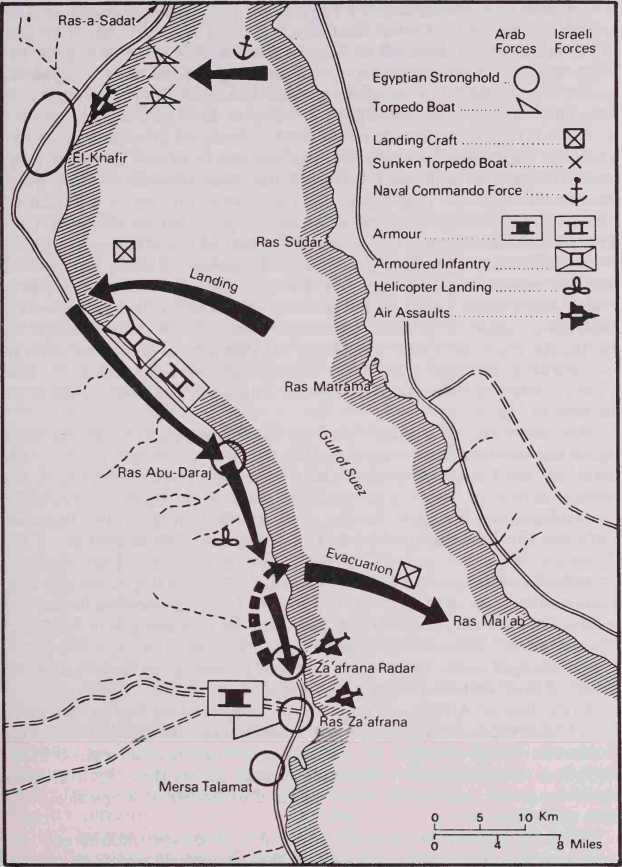From a military point of view, the most significant change in Israeli policy was the decision to throw the Israeli Air Force into the battle and utilize it as ‘flying artillery’ rather than to increase the strength of ground artillery.* This policy was to prove later to have been a grave error. Preconceived concepts that placed excessive emphasis on armour and air as against a more balanced force came to expression at this point, with results that were to prove very costly in the 1973 Yom Kippur War. While this policy was to prove to have been a major error in Israeli calculations from a long-range, strategic point of view, from a short-range tactical point of view it proved to be an unmitigated success. But, in the longer term, it created an imbalance in the Israel Defence Forces, with insufficient emphasis on supporting arms such as artillery and armoured infantry. The Egyptians’ preponderance in artillery continued to be a major factor in the balance of power.
Israeli air operations inevitably brought on an Egyptian air reaction, and dogfights developed along the Canal. In the course of July 1969, five Egyptian aircraft were shot down: two MiG-21 s, one Sukhoi Su-7 and two MiG-17s (the latter pair by anti-aircraft fire). The main Israeli targets were the Egyptian artillery emplacements and the SAM-2 surface-to-air missile bases that protected them. In less than two months after the opening of the Israeli air offensive, the Israeli Air Force completed over 1,000 sorties against Egypt, as against 100 Egyptian sorties in the same period, during which the Israelis lost three aircraft as against a loss of 21 by the Egyptians.
The main aircraft used by the Israelis in this role was the McDonnell Douglas A4 Skyhawk.

Armoured Raid on the Western Shore of the Gulf of Suez, 9 September 1969
Meanwhile, the war raged along the Canal. Sniping, patrols, ambushes and intermittent shelling were all taking their toll and casualties on both sides rose. Between 8 and 11 September 1969, the Israelis mounted an operation that once again was unusual in its scope and nature. It opened
With Israeli frogmen sinking two Egyptian torpedo-boats at anchor at Ras-a-Sadat on the Gulf of Suez. Next day, an Israeli armoured battalion task force sailed across the Gulf of Suez in tank landing craft bound for the Egyptian coast on what was to prove to be one of the most imaginative operations undertaken to date by the Israel Defence Forces — an armoured raid in depth into Egypt. Landing at dawn on 9 September 1969 at A-Dir on the western shore of the Gulf of Suez, the armoured task force took the Egyptians by complete surprise. Many of the Egyptian units encountering this armoured force did not react because the last troop movements they ever expected to meet were Israeli forces on their side of the Gulf. Control and co-ordination of Egyptian forces along the Gulf proved to be inadequate, a fact that was exploited to the full by the Israeli raiders. By early morning, the force had reached its main objective, a military camp known as Ras Abu-Daraj. In the course of the assault, which was backed up by Israeli air attacks, the camp installations were destroyed, including the main objective of the raid, the radar tower in the camp. Having cleared Ras Abu-Daraj, the Israeli force continued south to Ras Za’afrana, where more radar installations were destroyed. At that point, the Israeli force embarked on landing craft and returned safely to its base in the Sinai.
This raid came as a great shock to the Egyptians, emphasizing once again the vulnerability of the Egyptian defence system and the fact that Israel did not feel bound to fight along fixed lines. For over ten hours, the Israeli armoured force had operated at will in Egyptian territory, traversing some 30 miles in the process, destroying twelve Egyptian outposts and warning stations and inflicting over 100 casualties on the Egyptian forces. It proved to have been one of the more daringly conceived Israeli operations, well planned, with a high degree of inter-arm co-operation. By the time the Egyptians fully appreciated what was happening, the triumphant Israeli force was on its way back to the Sinai. Nasser himself suffered a heart attack after this operation, and there were major changes in the Egyptian Command, including the dismissal of the Chief of Staff and the commander of the Navy.
As the War of Attrition continued, the number of air battles increased. On 11 September, the Egyptians lost eleven aircraft (seven MiG-2 Is, three Sukhoi Su-7s and one MiG-17) for the loss of one Israeli aircraft. Still the Egyptians mounted their commando attacks across the Canal, artillery duels continued, and the Israelis conducted a number of long-range raids into upper Egypt.
The most spectacular operation in this period was undoubtedly the assault on the radar station at Ras-Arab for the purpose, not of destroying the position, but of capturing and removing the equipment, the total weight of which was seven tons. The acquisition of this latest P12 type of Russian radar would prove to be invaluable for the Israelis and for the Western powers in electronic countermeasure warfare. The Israeli force crossed the Gulf of Suez to Egypt, and reached the area of the radar station in CH-53 helicopters. The Air Force bombed targets in the vicinity to divert attention, while the raiding party made its way to the radar
Station. The attacking force overcame the Egyptian garrison, killing some and capturing others. Then, in a race against time, the raiding party managed to extricate the caravans containing the radar equipment, which had been partially buried in the ground; the principal trailer was harnessed by special steel hawsers to a helicopter, and the second trailer was lifted by a second helicopter. Both helicopters succeeded with great difficulty in transporting the very heavy equipment to the eastern shores of the Gulf of Suez. For the first time, the military establishment of Israel (and of many Western countries) were afforded an intimate view of a Russian P12 radar installation.
The opening days of 1970 afforded evidence of the fact that the Israeli strategy of counter-attrition was beginning to have its effect upon the Egyptians. The daring Israeli raids had to a degree knocked the Egyptian Command off balance, and the immediate effect of the massive use of Israeli air power proved to be very telling indeed. The Egyptians activated their surface-to-air missile system based on the Soviet SAM-2 type missile, but, three times in the course of the period between the opening of the offensive in July 1969 and January 1970, the Israeli Air Force succeeded in destroying a considerable part of the Egyptian air defence system. Israeli aircraft were beginning to range far and wide inside Egypt and to engage Egyptian targets in depth. The effect on the Egyptian public was marked, and the internal effect on Nasser’s regime became a matter of concern for him. In the Kremlin and elsewhere in the Soviet empire, they watched with growing concern as Western-type equipment flown by Israeli pilots operated with comparative impunity against a system of air defence similar to that protecting the Communist bloc against the West. The effects of the blows that Israeli forces inflicted on the Soviet-supplied Egyptian defence system was being noted by the military establishments throughout the Soviet bloc. The Israelis pounded the Canal positions. In the period under review, 48 Egyptian aircraft were lost as against five Israeli aircraft. The Israelis had seized the initiative. And, as the Israeli offensive persisted, a note of growing desperation could be detected in Egyptian public reaction — even more in Egyptian reports to the Soviet Union.
The Israeli counterattack against the War of Attrition waged by the Egyptians and the other Arab countries in violation of the cease-fire agreement was proving to be a considerable success in its first phase, namely from July to September 1969. During this period, Israel achieved complete superiority in the air as a result of a number of decisive air battles. This was followed by the second phase, which entailed the destruction of Egyptian anti-aircraft missile and radar defences in order to give Israel a comparatively free hand over Egyptian air space. The third phase was basically a psychological phase, that of bringing home the facts of the situation to the average Egyptian citizen by means of attacks on military installations in the neighbourhood of Cairo and other cities and, what was perhaps of greater importance, to the second line of Egyptian forces including reserve formations and units not directly affected by the fighting along the Suez Canal. This phase began on 7 January 1970.
The developments in the fighting along the Suez Canal, where the Israeli Air Force now had a comparatively free hand over Egyptian air space, the Egyptian anti-aircraft system lay to a considerable degree in ruins and Israel was gradually gaining the upper hand in the War of Attrition, were hidden from the Egyptian public by a controlled press and media. The purpose of the new Israeli offensive was to bring home to the Egyptian public the true facts and thus give rise to pressures from below in favour of reinstating the cease-fire agreement. The Israeli attacks were mounted against military targets deep in Egypt, including supply and ammunition depots, headquarters, military training centres, all within a radius of 25 miles of Cairo. Again and again these targets were attacked, and the citizens in Egypt’s capital city were alerted frequently by air-raid warnings. The Egyptian public gradually realized that the Israeli Air Force was operating freely in the skies of Egypt.
Meanwhile, as Israeli attacks were being mounted in depth against Egypt, the battle along the Canal and the Gulf of Suez was being waged sporadically. On 22 January, units of the Israel Defence Forces attacked and occupied the island of Shadwan, situated some 20 miles from Sharm El-Sheikh in the straits linking the Gulf of Suez with the Red Sea. In the course of the battle, 30 Egyptian soldiers were killed and many others taken prisoner, while two Egyptian torpedo-boats of the PI83 type were sunk. After occupying the island for 30 hours, the Israeli force withdrew, bearing with it all the military equipment including the radar installation on the island, which they had dismantled, and 62 prisoners. Israeli casualties were three dead and six wounded. The cumulative effect of such attacks against Egypt on all sectors was having its effect and, indeed, the Israeli forces along the Canal suffered the lowest number of casualties in January 1970 in any given month since the opening of the War of Attrition: six killed. A growing tone of concern could now be detected in Egyptian public statements. Nasser appealed to the Soviet Union.




 World History
World History









